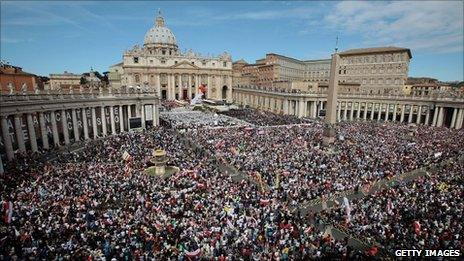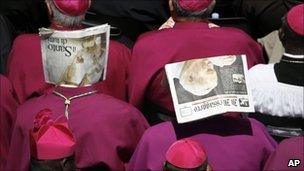John Paul II beatification: Celebration and ceremony
- Published

From Poland, Spain, France, Germany, the US, Britain, Canada and Brazil, from Sicily and from the Italian Alps, the pilgrims arrived - first a trickle, then a crowd, and finally a flood, a tsunami of believers, and they swamped Rome in the early hours of Sunday.
Some prayed in eight churches that had remained open all night, others simply bedded down for the night in sleeping bags in the street.
By dawn, on a fine May Day, the vast concourse of Saint Peter's Square in front of the Basilica was already full.
Nuns strummed guitars, young Catholics sang hymns in many languages, countless Polish pilgrims - as many as 200,000 according to some reports - streamed into all the streets surrounding Vatican City until there was literally no elbow room.
New Blessed
The crowds even overflowed into the small courtyard of the BBC bureau right next to the Vatican.
They could see nothing of the ceremony taking place behind the colonnades of Saint Peter's a mere 100m away.
Two women from the Czech Republic and an Italian family with their one-year-old baby from Trent - the city which hosted the Counter-Reformation - even nosed their way into our office to watch the TV coverage.
They left a message thanking the BBC for our "providential" hospitality.
A larger-than-life photograph of a smiling and relatively young Pope John Paul II was unfurled from the loggia of Saint Peter's Basilica as the new Blessed was proclaimed by Pope Benedict with a time-honoured Latin formula.
The 84-year-old Pope, resplendent in gold and white vestments, and wearing his Bishop's mitre, recalled how he had worked here at the Vatican side-by-side with John Paul during more than two decades.
He came to know the new Blessed intimately, he said, and he praised John Paul II for "restoring to Christianity its true face as a religion of hope".
Nun's cure
At the end of the ceremony, Pope Benedict went to pray in front of the casket containing the remains of John Paul II, exhumed from the tomb in the crypt of Saint Peter's Basilica in which he was laid to rest when he died, and now placed temporarily in front of the high altar.

The ceremony took place beneath the hot sun of Rome in May
A slightly macabre note was struck with the appearance of the French nun who claims to have been miraculously cured of Parkinson's disease after the death of the Pope. It was the very same malady which afflicted the late Pope.
She carried a silver reliquary in the centre of which is a glass test tube containing a blood sample taken from the Pope during his final illness, in case he needed a transfusion.
The sealed wooden coffin does not appear to have deteriorated during the years since his death.
Pope Benedict touched it and then brushed the wood with his lips.
The cardinals and VIPs from abroad were then allowed to do the same.
John Paul II will be re-interred in a side chapel in the Basilica. The remains of the previous occupant, Pope Innocent X, have been rather unceremoniously moved to another location.
Unanswered question
In addition to the homage paid by religious leaders, crowned heads of European royalty, and the many foreign heads of state and government present in Saint Peter's Square, an unusual tribute arrived from the man who tried unsuccessfully to assassinate the Pope in 1981.
Ali Agca served a 24-year prison sentence in Italy for his crime but he is now a free man.
"Blessed Pope John Paul - who called me his brother when he came to see me in prison - is a role-model for the whole world to follow," he wrote.
The final chapter in the investigation into who really was responsible for the shooting of the Pope has yet to be written.
And it is still not certain if and when Blessed Pope John Paul II will be proclaimed a saint.
There are still some Catholics who seek an answer to the question - if, as a leading Cardinal has said, the Pope was unaware of the clerical sex abuse scandals afflicting his Church during the final years of his pontificate - why should he have been uninformed about a matter which has brought only discredit to the world's oldest international organisation?
- Published1 May 2011
- Published14 January 2011